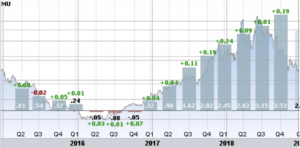By David Shakirov
UPDATE 03/21/2019: After a rise in the stock after earnings on 03/21/2019, I recommend to unload shares at $43.50, booking a 27.5% gain. An uncertain semiconductor supply/demand dynamic and higher valuation results in a more subpar risk/reward ratio. However, the gain booked from this article is an impressive 15% above the S&P 500, for a total gain of 27.53%.
Tech stocks are no longer the loud, hard partying rock and roll band of the equity markets. Although the S&P 500 has declined 10-11% over the last three months, the technology sector is trending lower (the NASDAQ 100 is down 14% in the last 3 months). At one point a sweetheart of momentum investors, AAPL, for instance, is spurring a love-hate relationship with its shareholders with lowered transparency, demand issues, and a 30% decline in its share price. Micron (MU), however, is even more extreme.
An American chip-maker based in Idaho, Micron is in the memory-supply business, including RAM, solid state, flash drives, etc. — a key component of most electronic devices. Micron tailors memory products to customer specifications, and sells through either online or in-person sales representatives. Approximately half of its net sales stem from its ten largest customers including Oracle, GE, Google, and Cisco — major players in the cloud computing, networking, and analytics businesses. To make its memory chips, MU relies on a small number of Chinese suppliers for raw materials (including silicone, chemicals, rare-earth metals, etc.), while 88% of its orders originate outside the United States — making its business model vulnerable to tariffs, shortages, or transportation mishaps.
Since mid-2016, however, RAM prices and demand have skyrocketed, which may account for Micron’s revenue growth from $12.4B (FY2016) to $30.4B (2018). Its stock gained strong momentum, lifting from its sub-$10 low to a high of $60 over two years as analysts cited the company as “generating increasing profits” (Benchmark) and pointed to its attractive valuation (Wells Fargo).

After underperformance in 2016, Micron’s Earnings Per Share have been steadily increasing for the past two years (grey bars), beating analyst expectations for 8 straight quarters (green figures). Source: E-Trade
Since late-May, MU has declined almost 50% to $33 as analysts began to see cracks in RAM pricing and demand, an attack on Micron’s core business. Analysts focused on declining EBITDA given the weakness in its business environment. However, firms like Moody’s have reiterated that, for example, debt-to-EBITDA will continue to be sub-1 while RAM pricing is simply a cyclical (not structural) downturn.
The PHLX Semiconductor Index (SOX), a metric cited by MU’s 10-K as an accurate measure of the semiconductor market, has trailed 15% down from its peak in late May. Some of Micron’s largest competitors, including SK Hynix, have trailed down 35% (compared to Micron’s 50% drop). Given that these companies operate in the same memory-business, Micron seems to be hit hardest by the cyclical decline in prices.
Although it faces a more difficult than expected business environment, MU may now trade at an attractive valuation. Since 2016, it has paid down debt (from $12B to $11B) while doubling assets (from $22.5B to $43B) and nearly tripling revenues. Its short term liquidity is not concerning (current ratio of 2.8x) while its debt profile is quite small (debt/equity of 0.14x). Operating income, a large focus for MU investors, has increased from $13.3B in 2014 to $15.8B in 2018. These metrics point to a strong balance sheet position and rising revenues/income. Investors are more focused on the cyclical decline in the memory-business, however, and not company fundamentals..
Given its healthy financials, the memory business landscape is a catalyst for the stock. M As competition between MU and its competitors (including Samsung and Chinese firms such as SK Hynix ) intensifies, fears of oversupply and hence memory price deflation emerge. Micron admits that the Chinese government’s direct investment into Chinese semiconductor companies poses a competitive (and possibly “unfair”) risk. Nevertheless, Micron has close to $7B of cash to spend on R&D — a significant moat for its competitive advantage, given it only spent $2.8B on research and development in 2018. Given the tough semiconductor/memory environment and tough competition, it may make sense for MU to increase its R&D expenses to protect itself even further. ? Demand, however, should grow as the development of virtual reality, cloud storage, and machine learning expand, as Micron provides a significant amount of product for these memory-reliant industries. Investors, however, seem more worried about cyclical changes in memory pricing, rather than long term sustained growth in demand.
Even if we modeled a 10% decrease in memory prices, a stagnant market share, poor worldwide RAM demand (15% total growth from 2018 to 2025), and flat margins, we would still expect a $45 price target on the stock (given a discounted cash flow analysis, performed by Trefis).. This case incorporates very conservative inputs. A more realistic case, however, incorporates declining memory prices, a continued trend of increasing market share (given rising R&D investments from its strong cash position) at slower rates to 40% in 2025 (from 35% in 2018), and 20% total growth in the DRAM market until 2025. This points to a price target of $60, or 80% upside from its $33 price.
Micron will be announcing earnings after the bell on December 18th. If it addresses the state of its business environment — the memory market — by either pointing to improvements in the market or MU’s adaptation to the price/demand pitfalls, investors may feel relieved. Rather than focusing on the short term cyclical pricing of memory, value investors should use MU as a cheap vehicle to profit from the expanding memory market. Micron’s stock price is like a loaded slingshot, pointed up. With little downside left after a 50% decline and a catalyst earnings call, it would be hard for a disappointing news to depress the stock even more. As the third largest player in a market that naturally expands with the growth of technology, in addition to a prime financial position and an oversold price (with an RSI of 40) investors should find peace in the $45-50 range within the next 6 months.
